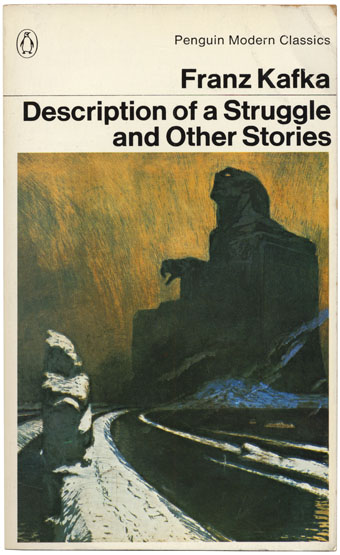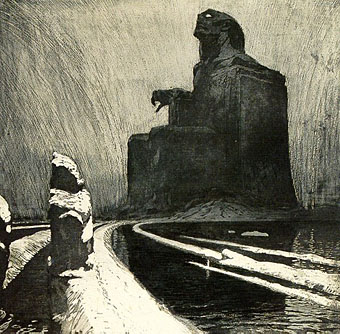
And speaking of Kafka, today’s book purchase was this 1979 story collection. The picture on the cover is a coloured aquatint and my favourite work by Czech artist Frantisek Kupka (1871–1957).

Resistance, or The Black Idol (1903).
Kupka is one of the more unique artists of the period, having begun his career in the Symbolist mode then abruptly changed course, post-Cubism, to become one of the earliest abstract painters. Kandinsky and Mondrian followed a similar evolution but little of their early work is valued, whereas Kupka’s Symbolist pastels and etchings are still regarded as significant. This page has several of his pictures on mystical themes.
As well as being a good match for Kafka, The Black Idol was also the model for the ruined castle in Francis Coppola’s Dracula. There aren’t any decent pictures around, unfortunately, but if you must you can go and squint at the screen grabs here.
Elsewhere on { feuilleton }
• The book covers archive

‘The Path of Silence’ along with ‘The Black Idol’ are the two of his pictures I’ve most commonly seen in Symbolist anthologies, though another common picture of his involves a dwarfish green creature pregnant with something irridescent, though I’ve never seen it online. I do wish Kupka had gone back to dabble in his old craft every now and then as he was, to begin with, one of the strongest symbolist artists I think.
If one excludes the almost soap opera-like second half, I would then say that Coppola’s is the best dracula as far as I am concerned. Many other symbolists’ work was used in inspiration, such as Klimt’s in some of the costume design, and as someone with a bit of Romania in his background (not as if its shaped me at all significantly) it was nice to see a director actually give Transylvania and its inhabitants their own indigenous look and not the standard rich Austrian look that seems to be more popular for some reason.
I guess you’re thinking of Kupka’s ‘Money’?
http://cgfa.sunsite.dk/k/p-kupka2.htm
I wish he’d done more along these lines as well although I understand the way artists must have felt then, suddenly being able to do things that hadn’t been tried before.
Lots of things to like in Coppola’s Dracula: great design throughout, with the lighting, sets and costumes. Dracula’s three brides are wonderfully decadent femmes fatale. I also like the way it doesn’t care about being too “real”. It’s pretty much his last decent film.
You can find a pretty good book about figurative book of Kupka here
http://www.amazon.fr/Vers-temps-nouveaux-Frank-Kupka/dp/2711844838/
Another about his work on Cantic of the cantic (?)
http://www.amazon.fr/Cantique-Cantiques-Par-Kupka/dp/2702207669/
He is my favourite artist for the moment and I plan to make a comics about his life one day :-)
Thanks so much for posting this. I’m currently doing an art coursework piece about art’s influence on classic horror imagery, and I came across this post. Very helpful – thanks!